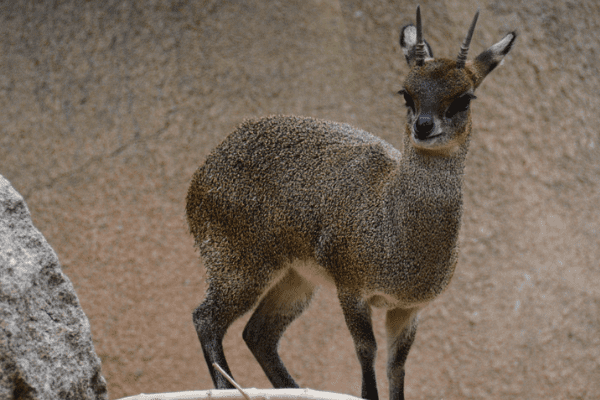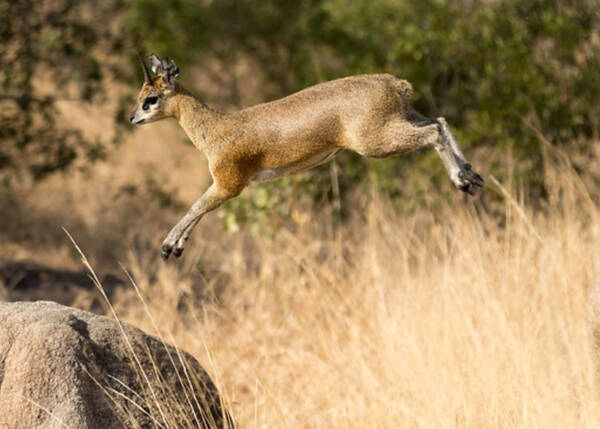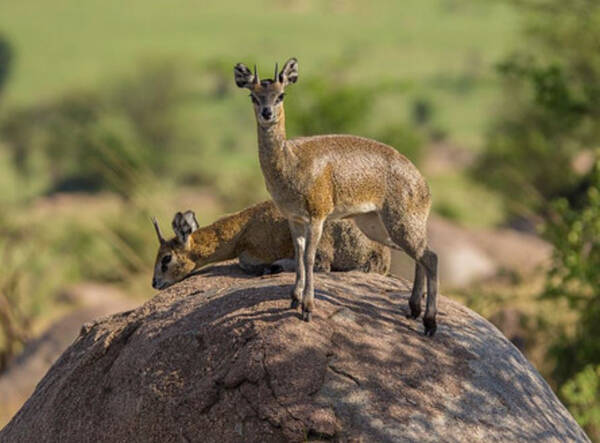Oreotragus oreotragus
IUCN
LCBasic Information
Scientific classification
- name:Oreotragus oreotragus
- Scientific Name:
- Outline:Ungulata
- Family:Artiodactyla Bovidae Antelope
Vital signs
- length:75-115cm
- Weight:8-18kg
- lifetime:About 17 years
Feature
The fur is thick and coarse, yellow and gray, with gray and white spots, and almost tailless.
Distribution and Habitat
Found in Angola, Botswana, Central African Republic, Democratic Republic of Congo, Djibouti, Eritrea, Eswatini, Ethiopia, Kenya, Malawi, Mozambique Namibia, Nigeria, Rwanda, Somalia, South Africa, South Sudan, Tanzania, Uganda, Zambia and Zimbabwe.
Possibly extinct: Burundi.
Uncertain existence: Lesotho.
Widely distributed, starting in northeastern Sudan, Eritrea, northern Somalia and the Ethiopian highlands, southward through East Africa and South Africa (including southeastern Democratic Republic of Congo) to northeastern South Africa, and then to southern South Africa and along the west coast into Namibia and Angola.
Reachable altitudes of 4,380 m. Restricted to rocky habitats, including rocky hills, isolated outcrops or rocky canyons. Also inhabits the Zambezi River Valley and the southern escarpment area, the species also travels along flat land between isolated rock formations for up to 10 km. It is often found near cliffs and rocky outcrops and in flatter areas of bu
Appearance
The klipspringer is a small antelope, weighing between 8-18 kg, with females slightly heavier than males, averaging 10.6 kg for males and 13.2 kg for females. Body length is 75-115 cm, with females slightly longer than males, averaging 86.2 cm for males and 90.5 cm for females. Height varies less, ranging from 43-51 cm. In South Africa, only males have horns, while in eastern Africa (Kenya and Tanzania), both males and females of the klipspringer subspecies have horns. The latter may be the result of greater competitive interactions in the eastern regions. In general, the horns are short and straight, forming a ring only near the base. The horns begin to grow after 4 months, protrude from the top of the head after 5.5-6 months, and reach the size of adult horns after 17-18 months. The average length of the horns is 10 cm, and the record length can reach 16.2 cm.
This is a sturdy little antelope with a short neck and body and large hindquarters, which helps them jump from rock to roc
Details
Oreotragus oreotragus (English: Klipspringer, French: Oréotrague, South African: Klipspringer, German: Klippspringer, Dutch: "rock jumper"), with 11 subspecies.

The average territory of the Oreotragus is about 0.081 square kilometers. The size of a male's territory will depend on the average annual rainfall in the area. If rainfall is high (1300 mm in the Ethiopian Highlands), the territory will be smaller (0.08 km2), and if rainfall is low (400 mm in the Karoo of South Africa), the territory will be larger (0.15 km2). Klipspringers deposit feces around the boundaries of their territories to mark their territory. More commonly, they do so by smearing their orbital gland secretions on bare branches or grass clippings, leaving a 4-6 mm black glandular mark. Klipspringers revisit their scent marks every 7 days, corresponding to the length of time the scent remains detectable. Both males and females mark territories by scent marking, but males will usually follow females to mark areas she has been to. This scent marking behavior reinforces pair bonding and reinforces territorial marking.
Klipspringers generally travel alone, in pairs, or in family groups of male and female pairs and their offspring. The average group size is 2.6 individuals. They are active during the day and night, but are most active in the early morning and afternoon. They tend to hide in the shade for the rest of the day to avoid the heat. When the weather is cool, they will remain active throughout the day. When a klipspringer invades another klipspringer's territory, the male will chase the intruder away. If the intruder persists, hostile attacks such as sovereignty displays, defensive displays, and fighting as a last resort will occur. Dominance displays include fighting displays without lowering the front of the body, while defensive displays involve lowering the head while sticking the chin out while biting the intruder. Fighting males will lower their heads and use their horns to butt their buttocks, while females will bite each other's fur.

Pair bonding in mountain antelopes may be an adaptive state that allows for increased vigilance in open habitats. Although mountain antelopes maintain close proximity and are aware of each other's behavior and location, actual contact between members is very rare. The median distance between a pair of mountain antelopes was recorded as 2 meters. In addition to mutual grooming, alarm is important in maintaining pair bonding in territorial marking. When a predator is approaching, the first reaction of a klipspringer is to stand still. If a predator approaches, a klipspringer will give a loud alarm call that can be heard from 0.7 km away. This call is exhaled through the mouth and nostrils. After giving a call, the klipspringer will run 30-50 meters to a higher ground, followed by the males from behind. Once at a safe distance, the male and female will turn toward the predator and continue to give alarm calls, with the male's call immediately following the female's call. It has been suggested that the alarm call is to convey the klipspringer's awareness of the threat to the predator, rather than to alert other klipspringers.
Klipspringers feed primarily in the early morning and late afternoon, with short feedings throughout the day. Klipspringers spend 15%-41% of their day feeding. While they feed, one of the members stands and looks around to remain alert. The male is usually the guarding member, as the females need more time to feed and accumulate energy for lactation. Another option is that females lead from one feeding area to another, which may be due to the high demand for food in females. During feeding, klipspringers never stand in one place to feed, but move from one plant to another. They have a narrow muzzle, which helps them to selectively feed on plant parts. In some cases, they stand on their hind legs to reach specific fruits or flowers.
Due to their small size and high metabolic rate, klipspringers have higher energy requirements per unit body weight than larger antelopes. Because of their small stomachs, they cannot take in too much food; therefore, they selectively feed on plants with high nutrition. Klipspringers are frugivores and folivores, feeding primarily on fruits, flowers, and horn pods of plants such as Maytenus oleoides, Ximenia caffra, Pseudolachnostylis maprouneifolia, Rhus unvolata, Aspalathus hirta, Combretum molle, and Dichrostachys cinerea. In fact, fruits and flowers make up about two-thirds of a klipspringer's diet. Generally, klipspringers will not feed on grasses, even if young shoots are edible. However, when it is winter or when the weather is dry, klipspringers will eat more leaves, as nutritious plants are not abundant. Due to living in an arid habitat, klipspringers consume very little water. They get most of their water from the water that accumulates on their food or plants. Klipspringers occasionally feed on succulents, plants with thick, fleshy leaves or stems, to obtain water, but not nutrients. When water is available, they drink from temporary pools, puddles and streams.

For the klipspringer, if a predator is far away and is not considered an immediate threat, the klipspringer will pay attention and confront their predator. If in low visibility conditions, the klipspringer will move to higher ground in order to see potential danger. If the predator remains still, the klipspringer will eventually become relaxed. Klipspringers are more vulnerable to predation than other African antelopes because they live in open habitats. Despite this, klipspringers can outrun their predators. Predators of the klipspringer include leopards, caracals, spotted hyenas, Asian jackals, wild cats, Ethiopian wolves, baboons, black eagles, tawny eagles, and fierce eagles.
During mating, the male follows the female closely while occasionally raising his front legs. The male may also make a low, humming call and arch his neck to show his dominance. Mutual nibbling of the preorbital glands has also been observed in zoos. Female klipspringers give birth to one offspring every 16 months. The breeding season is usually between August and September, but may also vary depending on local conditions. Once mating occurs, the fetus is implanted in the female's right uterine horn. The gestation period is about 6 months. The breeding season is in spring or summer, when females give birth under the shelter of rocks and vegetation. The young weigh about 100 kg at birth. The young remain hidden for the first 2-3 months after birth, and the females nurse for about 3-4 months. The young are weaned after 4-5 months and reach sexual maturity after 7 months. After about a year, the young mountain antelopes reach the size of adults. Males leave the group early (about 6 months after birth) to establish new territories, while females can stay in a group for 10-11 months.
Mountain antelope calves mature early at birth. Therefore, they do not require much attention from their mothers. Although males are not responsible for raising their young, they can indirectly help the young by protecting their territories from predators and potential competitors. According to records, mountain antelopes in captivity can live up to 17 years and 10 months. There are no records of the lifespan of mountain antelopes in the wild.

The total population of the klipspringer is estimated at over 40,000 individuals (likely an underestimate). 25% of these are in protected areas. The population of the klipspringer in many protected areas and on private land is considered stable, with large numbers of klipspringer in unprotected but inaccessible habitats. The species is not considered to be near the threshold of any threatened category and has been certified as Least Concern. As long as the species continues to be actively protected in national parks and equivalent protected areas, hunting permits, and private farmland, the conservation status of the species will not change and its future should be secure. They should also continue to survive in large numbers in vast uninhabited areas that are not protected.
There are no apparent major threats to the klipspringer throughout most of its range. Their habitat is of little value to humans and they persist outside protected areas in areas where subsistence hunting pressure is low. The klipspringer has adapted to the inaccessible slopes and cliffs of these areas, thus avoiding most competition from domestic herds. Small, isolated populations in relatively small areas of rocky habitat are more vulnerable to hunting and competition from goats, and many of these populations have been decimated in settled areas.
About a quarter of all klipspringers live in protected areas, including: Simien and Bale Mountains (Ethiopia), Tsavo (Kenya), Luangwa (Zambia), Nyika (Malawi), Namib-Naukluft (Namibia), and Matobo (Zimbabwe), and smaller numbers are also found in many other protected areas throughout the range that contain smaller amounts of suitable habitat (Roberts 2013). A large proportion of klipspringers survive on private farmland in Namibia. Klipspringers avoid densely populated areas, such as the Cape Peninsula and parts of the Karoo. Otherwise, they are common in unprotected areas without settlement and livestock. They have particularly large populations in protected parks, including: Tsavo National Park (Kenya), Nyika National Park (Malawi), Namib-Naukluft National Park (Namibia), and Matobo National Park (Zimbabwe).
Listed in the IUCN Red List of Threatened Species in 2016 ver3.1 - Least Concern (LC).
Protect wild animals and eliminate game.
Maintaining ecological balance is everyone's responsibility!








